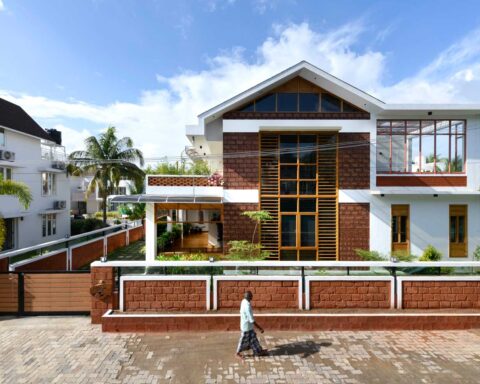[vc_row][vc_column][vc_custom_heading text=”A pavilion that celebrates the heritage of hospitality in the spirit of tomorrow.” use_theme_fonts=”yes”][/vc_column][/vc_row][vc_row][vc_column][vc_column_text]Project Name : Desert Pavilion
Project Location : Jordan
Architects/Designer : MEAN – Middle Eastern Architecture Network
Instagram : @mean.design[/vc_column_text][/vc_column][/vc_row][vc_row][vc_column][vc_single_image image=”16505″ img_size=”large”][/vc_column][/vc_row][vc_row][vc_column][vc_column_text]text description by the architects.
MEAN* designed a 3D printed pavilion for welcoming visitors into the desert of Wadi Rum, south of Jordan.
The space serves as an oasis of rest and communal gathering.
Drawn to its otherworldly beauty, The desert of Wadi Rum in the south of Jordan attracts visitors from all over the globe.
The topography of Wadi Rum closely resembles that of Mars. This serene desert landscape had been a stage for many space-age movies such as ‘The Martian (2015)’, ‘Rogue One: A Star Wars Story (2016)’ and ‘The Last Days on Mars’.
Taking reference from the lightweight geodesic dome system of ‘Mars Camp’ which is located on a plot near the site, the design team envisioned a novel system of 3D printed panels that can be deployed onto a CNC bent, steel pipe system.[/vc_column_text][/vc_column][/vc_row][vc_row][vc_column][vc_single_image image=”16506″ img_size=”large”][/vc_column][/vc_row][vc_row][vc_column][vc_column_text]Designed with a unique overlap of Bedouin Heritage and Space-Age Technology.
MEAN utilised generative design methods to simulate a holistic structure: a hybrid of a 3D printed polymer shell on 3D printed concrete topography.
Inspired by the ingenuity of the mobile architecture of the local Bedouins, we were inclined to simulate a tent-form using the ‘Mesh Relaxation’ parametric strategy, which generates a digital Catenary mesh geometry, in equilibrium.[/vc_column_text][/vc_column][/vc_row][vc_row][vc_column][vc_single_image image=”16507″ img_size=”large”][/vc_column][/vc_row][vc_row][vc_column][vc_column_text]An Oasis of shade and a micro-ecology within the desert.
The points of which all the field lines emerge from the center where the supporting pipes are grounded, forming funicular touch-points, around which seating areas are allocated. At the center, desert trees and shrubs are planted to regulate the atmosphere of the interior. These funnels also act as ‘light-wells’ capturing natural daylight and channeling it into the space. The panels making up the outer shell are tessellated for maximum efficiency for 3D printing. These tessellated panels filter light into the space while ensuring a well ventilated interior. At night, linear lighting fixtures that are aligned along the force field patterns, create a gentle ambient lighting within the interior.[/vc_column_text][/vc_column][/vc_row][vc_row][vc_column][vc_single_image image=”16508″ img_size=”large”][/vc_column][/vc_row][vc_row][vc_column][vc_column_text]A cross-temporal meeting point
The Desert Pavilion is the outcome of combining ideas from the site with current building technologies.
The structure is designed to form a space of shade from the heat of the desert during the day, and a place of celebration, storytelling and rest, at night. It serves as a welcoming hospitable shelter for today and a case study for inhabiting the arid landscapes of Mars in the future.[/vc_column_text][/vc_column][/vc_row][vc_row][vc_column][vc_single_image image=”16509″ img_size=”large”][/vc_column][/vc_row]













